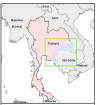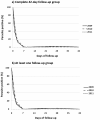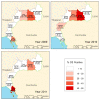Artemisinin resistance containment project in Thailand. II: Responses to mefloquine-artesunate combination therapy among falciparum malaria patients in provinces bordering Cambodia
- PMID: 22929621
- PMCID: PMC3445821
- DOI: 10.1186/1475-2875-11-300
Artemisinin resistance containment project in Thailand. II: Responses to mefloquine-artesunate combination therapy among falciparum malaria patients in provinces bordering Cambodia
Abstract
Background: The area along the Thai-Cambodian border is considered an epicenter of anti-malarial drug resistance. Recently, parasite resistance to artemisinin-based therapies has been reported in the area. The artemisinin resistance containment project was initiated in November 2008, with the aim to limit resistant parasites and eliminate malaria in this region. This study describes the response to artemisinin-based therapy among falciparum malaria patients in the area, using data from the malaria surveillance programmed under the containment project.
Methods: The study was conducted in seven provinces of Thailand along the Thai-Cambodian border. Data of Plasmodium falciparum-positive patients during January 2009 to December 2011 were obtained from the electronic malaria information system (eMIS) Web-based reporting system. All P. falciparum cases were followed for 42 days, as the routine case follow-up protocol. The demographic characteristics of the patients were described. Statistical analysis was performed to determine the cure rate of the current standard anti-malarial drug regimen--mefloquine-artesunate combination therapy (MAS). The proportion of patients who remained parasite-positive at each follow-up day was calculated. In addition, factors related to the delayed parasite clearance on day-3 post-treatment, were explored.
Results: A total of 1,709 P. falciparum-positive cases were reported during the study period. Almost 70% of falciparum cases received MAS therapy (n = 1,174). The majority of cases were males, aged between 31 and 50 years. The overall MAS cure rate was > 90% over the three-year period. Almost all patients were able to clear the parasite within 7 to 14 days post-treatment. Approximately 14% of patients undergoing MAS remained parasite-positive on day-3. Delayed parasite clearance was not significantly associated with patient gender, age, or citizenship. However, delayed parasite clearance varied across the study area.
Conclusion: Anti-malarial drug-resistant parasites should be closely monitored in the area along the Thai-Cambodian border. Although the MAS cure rate in this study area was above 90%, an increasing trend of treatment failure has been reported in neighboring parts. Effective malaria surveillance is an important component to monitor drug-resistance in the malaria containment project.
Figures




References
-
- World Health Organization. Containment of malaria multi-drug resistance on the Cambodia-Thailand border. Report of an Informal Consultation. WHO-Mekong Malaria Programme, Phnom Penh, Cambodia; 2007.
-
- World Health Organization. Guidelines for the treatment of malaria - 2nd edition. World Health Organization, Geneva; 2010. - PubMed
-
- Carrara VI, Zwang J, Ashley EA, Price RN, Stepniewska K, Barends M, Brockman A, Anderson T, McGready R, Phaiphun L, Proux S, van Vugt M, Hutagalung R, Lwin KM, Phyo AP, Preechapornkul P, Imwong M, Pukrittayakamee S, Singhasivanon P, White NJ, Nosten F. Changes in the treatment responses to artesunate-mefloquine on the northwestern border of Thailand during 13 years of continuous deployment. PLoS One. 2009;4:e4551. doi: 10.1371/journal.pone.0004551. - DOI - PMC - PubMed
Publication types
MeSH terms
Substances
LinkOut - more resources
Full Text Sources

